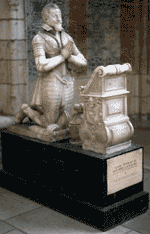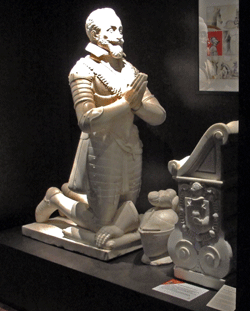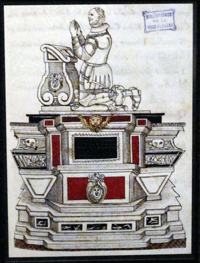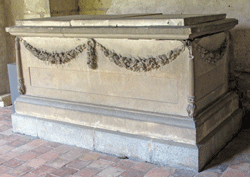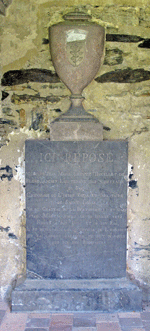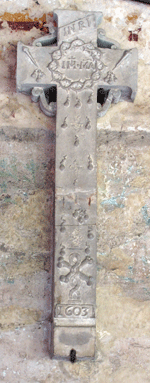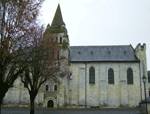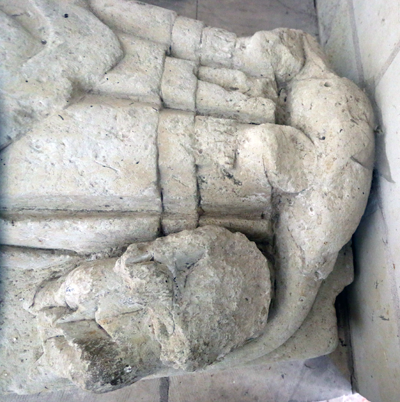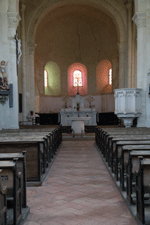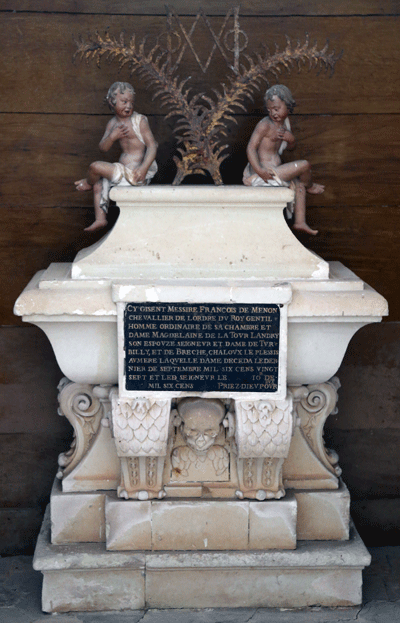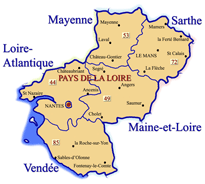 |
MAINE-ET-LOIRE |
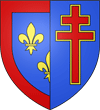 |
| ANGERS |
| Cathédrale Sainte-Maurice |
| Entrance to the cathedral is free; there are no restrictions on photography |
 |
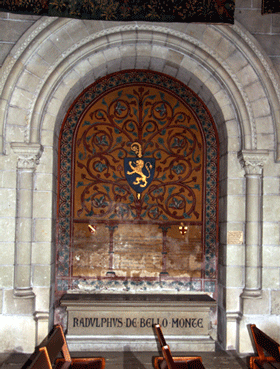 |
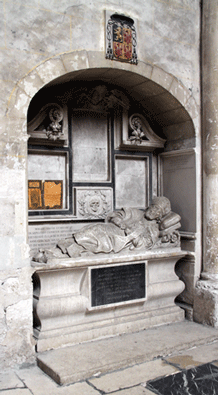 |
| Guillame Angebault
(1790-1869) Bishop of Angers (1842-1869) |
Radulphus de Bello Monte | Claude de Rueil (1649) Bishop of Angers |
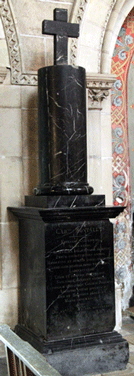 |
 |
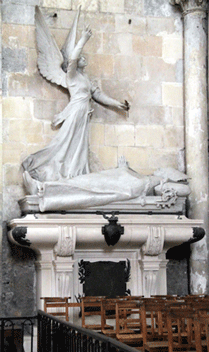 |
 |
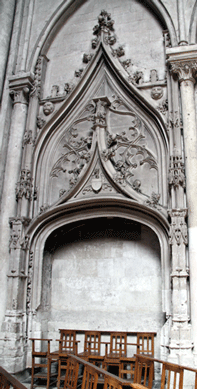 |
| Charles Montault Des Isles
(1755-1839) Bishop 1802-1839 |
Noel Pinot (1794) was a Refractory Priest who was guillotined during the French Revolution |
Charles-Émile Freppel (1891) Bishop of Angers. By Falguière |
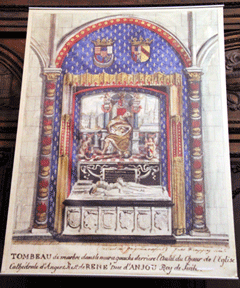 |
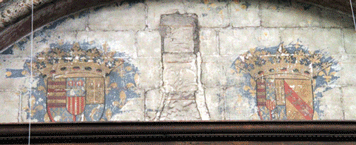 |
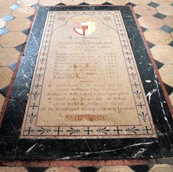 |
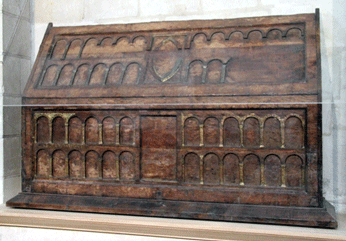 |
| Left:
Representation of the destroyed monument of 'Good
King René'
Note
the heraldry painted on the wall behind the monument, which may
still be see. Above Left: Wall painting, now mainly obscured by wooden panelling, in front of which was the above tomb. Above Right: A slab from 1850 commemorating members of the royal house of Anjou who were buried in the Cathedral and whose monuments were destroyed or never constructed. (see below) Right: Front of the mortuary chest of Ulgar, bishop of Angers 1125 - 1148. Oak, brass gilded and varnished. |
|||
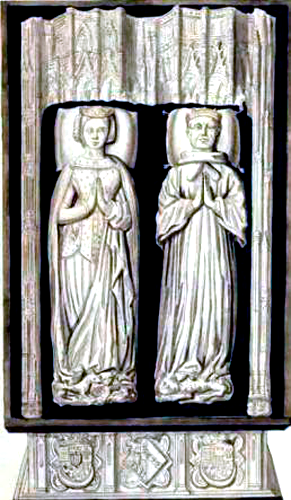 |
|
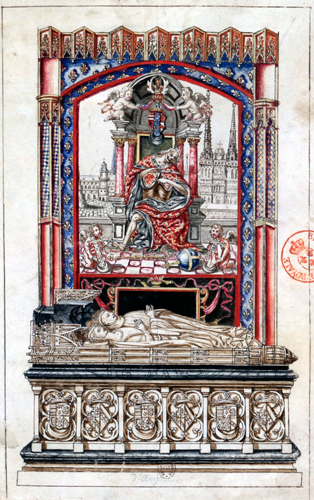 |
| Le Musée des Beaux-Arts |
| Entrance fee. Not a friendly museum: there
are rather a lot of 'thou shalt not' notices, including 'no
photography'. Other museums in Angers - or any other in France we have visited - do not follow this unfortunate practice. |
|
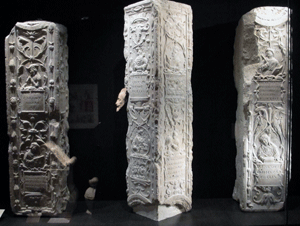 Above: Fragment of the tomb of Jean Olivier (1540), Bishop of Angers. Limestone |
||||||
| Collegiale Saint-Martin |
| This former collegiate church has been restored and is now a museum. |
 Slate grave slab 725 |
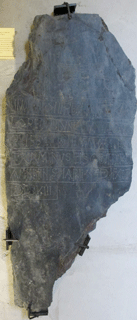 Ermdramnus, clerk. 3rd year of the reign of King Charles [771 or 774]. Slate |
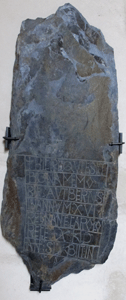 Autherus. 18th year of the reign of King Charles (789 or 792) |
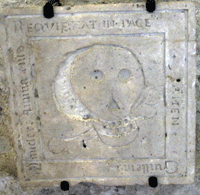 Gravestone of Guillemine Mauclerc Second part of 16th century Limestone  |
 Bathaldus. 3rd year of King Charles [771 or 774} |
 7th - 8th century sarcopagus from Poitiers area.  |
 Slate grave slab of a woman, wife of a lord |
|||||
 |
| Several early grave slabs and sarcophagi excavated in the church |
| St John's Hospital | ||||||
| This building was a medieval hospital which is now a museum housing the magnificent tapestries of Jean Lurçat in the former large hospital ward. There are also remains of a cloister, which contains the minor monuments shown below, as well as a chapel; the latter is not open to the public but I understand - although I have not yet confirmed this - that it contains possibly three effigies. The museum is worth a visit for the fine architecture as well as the amazing tapestries; as usual in France there is a modest entrance fee and photography is allowed. You can park across the road from the museum in a large free car park on the banks of the Loire | ||||||
|
||||||
| Château de Brézé |
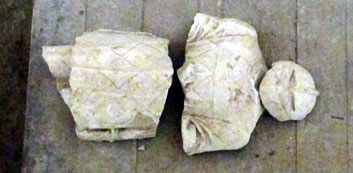 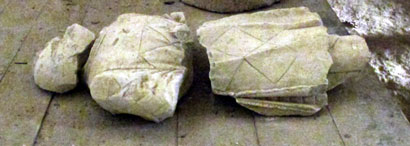 |
This is one of the 'Loire Châteaux', the style now being that of the Renaissance. However below the ground is a vast series of tunnels and rooms from the twelfth century. There is an entrance charge to the chateau; however there is a reduction (and as well as certain other monuments in the area) for those who have a season ticket to Fontevraud, which cost little more than a single visit. Opening times vary. Check on the website below: http://www.chateaudebreze.com/loire-castle-france.html Ref: 47˚ 10.12' N/ 0˚ 3.43' W |
|
| This is a fragmentary military effigy which looks late 15th - early 16th century, which I discovered in a store room in the subterranean part of the château. There is no indication of its origin let alone whom it may represent. |
 |
Cizay-la-Madeleine Abbaye Asnières |
 |
| Former Benedictine Abbey of around 50 monks,
founded by Barnard de Tiron, a colleague of Robert Arbristle,
the founder of Fontevraud. The abbey, now partly ruined, is about
10 miles from Fontevraud and about a mile outside the village of
Cizay-la-Madeleine. This village should be shown on
satnavs although the abbey will probable not be. It is shown in
the larger scale IGN maps. Head for Cizay-la-Madeleine and there
the abbey is signposted. Ref:
47°10.50'
N/ 0°12' W; Code 49 70 0 Open July to August 11.00AM - 6.00PM, except Tuesdays and/or Mondays. But check this on website. May also be open from mid May until 30th June except Monday and Tuesday. Entrance fee €6.50; children (8-18) 4€. Parking outside. Website: www.abbaye-asnieres.com E-mail: contact@abbaye-asnieres.com |
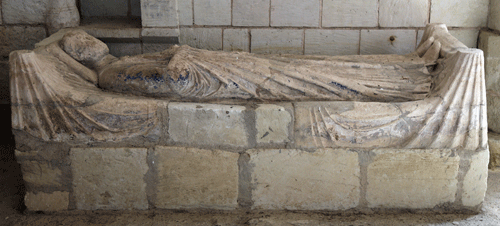 |
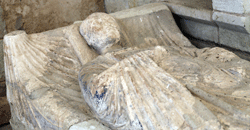
Abbot, early 13th C. This is very similar to the Fontevraud
effigies. Traces of original polychrome
|
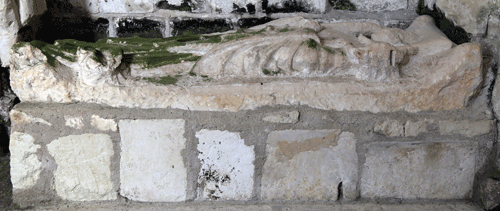 |
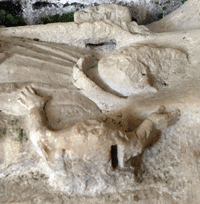 |
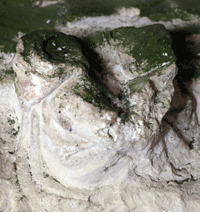 |
Another abbot but later. Very poor condition. There may well have been a draped bier carved as above and as the Fontevraud monuments but this is now difficult to determine. We now have in addion an animal (lion?) to support the feet and two angels at the head supporting a pillow. There is also a seated monk (?) near the feet of the effigy reading a book. Neither in situ. |
||
 |
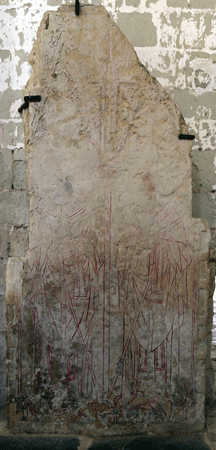 |

Far left: Incised slab of abbot
Left: Incised slab with pair of abbots. Canopies above the heads are just discernable. These are now clamped to the walls but all burials were in the choir Above: Modern floor slab dated 1744. Renee Cuiard |
 |
 |
 |
| Stone coffins in situ. Note the tiled pavement in the centre photograph. | ||
| Chênehutte - Trèves - Cunault | |||||||
| A commune on the south bank of La
Loire, west of Saumur Two of the three villages have churches with medieval effigies |
|||||||
|
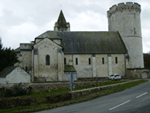 |
Trèves - St Aubin |
 |
| Church open - park outside
Ref: 47˚ 19.42' N/0˚ 11.51'W |
 |
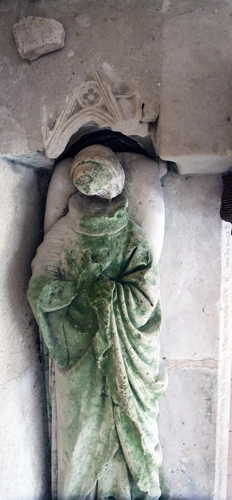 Effigy of Robert le Maçon (1443), Baron of Trèves and Chancellor of France in the time of Charles VII. He built the 'donjon',which can be seen next to the church. |
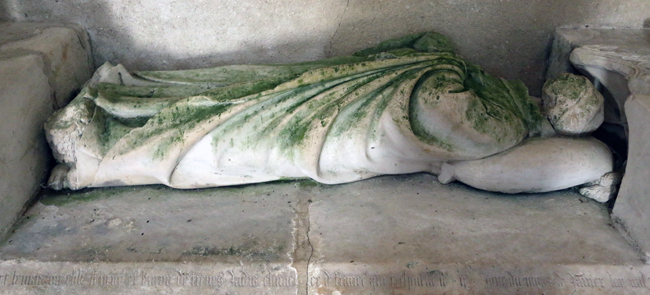 |
|
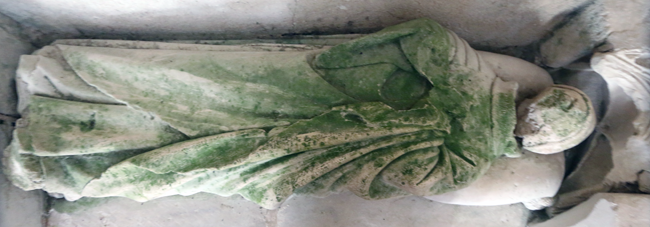 |
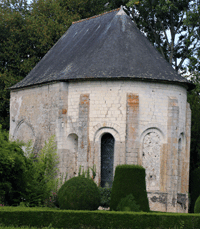 |
Denezé-sous-le-Lude |
 |
| Abbaye de la Boissière | ||
| The abbey is north of the village but do not enter the village but rather remain on the D767 which leads from Noyant (south) to Le Lude (north); the abbey is then signposted on your right - if you are travelling north - shortly after passing Denezé-sous-le-Lude. The abbey is on private property and only the chancel now remains, the rest of the buildings having being either demolished or converted into a private house. The abbey is open to visitors from 1st August to 15th September. There are no signs outside so it is not obvious on arrival where the actual entrance is to be found, so it may be better to telephone beforehand to ask for advice. Excellent English is spoken. Contact details may be found here. There is no charge for these individual visits. Parties of 20 to 80 persons may visit at anytime; but prebooking is required; there is a charge here of €5 per person. Park on the roadside outside. Ref: 47°33.2' N/0° 07.8'E |
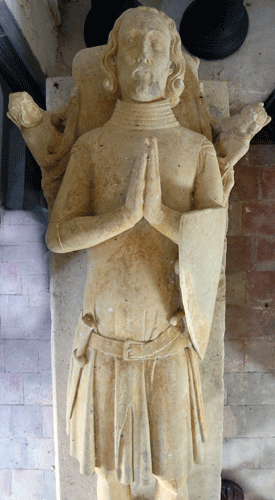 |
 |
 |
|
 |
|||
 |
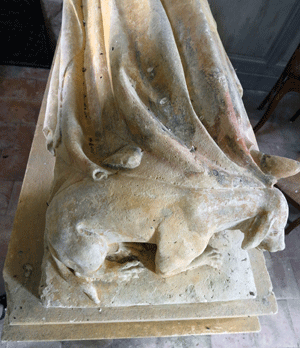 |
||
| These very fine effigies were discovered
buried in the monks' cemetery in the early 20th century, where
they are said to have been hidden during the French Revolution.
Some of the original polychrome can still be detected.
They are said to be of Guilleaume Chamaillard
d'Anthenaise (1391) and his wife Mairie de
Beaumont, both benefactors to the abbey.
The military effigy was originally situated in a niche
in the south wall of the Chapel of the True Cross. ( see below);
the lady was presumably originally, as now, in the abbey
church. |
 |
The Chapel of the True Cross |
 |
West of the abbey is the Chapel of the True Cross; this is so called because Jean d'Alluye brought back a piece of the true cross from Crete during the Crusade of 1239 (or Barons' Crusade) and sold it to the abbey, where it was initially kept. The chapel was built in 1246 specifically to house this relic, so that it could be venerated by pilgrims. |
 |
 Left: Exposed stone coffin with shafts of four long bones and fragments. These bones have been date to around the year 800. Above: Tomb recess, also visible in the interior photograph above. This originally contined the military effigy which is now in the church, above. |
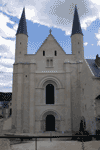 |
 |
Fontevraud l'Abbaye |
 |
 |
| The Abbey | ||||
| There is no parking at the Abbey, apart for those
staying at the
hotel, but there is free
parking offered by the Abbey just across the road as well as nearby in the town, where there are also free facilities for
camper vans. There is an entrance fee to the Abbey; seasons tickets are
also available for a little more and are very good value. There are no
charges for photography and tripods and flash may be used. When in
Fontevraud l'Abbaye also visit the medieval parish church and the
Lantern of the Dead (interior not yet open). |
||||
|
This
is a magnificent place to visit: the largest
monastic complex in western Europe which
originally housed five monasteries. There are
actually three churches on the site but that shown here is
that of le Grand Moutier. Old French for monastery) The church houses the painted tuffeau effigies of the English Kings, Henry II, and his son, Richard the Lionheart, Henry's Queen, Eleanor of Aquitaine and the wooden effigy of King John's Queen, Isabella of Angoulême. Why were they buried here? They were not only kings of England but rulers of an extensive area of what is now France: Dukes of Normandy, of Aquitaine, Counts of Anjou, Touraine and Maine and overlords of Brittany, often called the 'Angevin Empire', although this was not a contemporary term, being first used by Kate Norgate in the 19th century. Neither was it an empire and the expression would not have been recognised by those concerned. The kings died in France and the queens died in retirement in the Abbey. The church has been extensively excavated but no trace of coffins or remains have been found. However the effigies, which have moved around over the years, are now thought to rest where the burials took place, at the eastermost part of the nave. Henry and Eleanor's daughter, Joanne, who died in childbirth, is also buried in the Abbey but no monument has been found. Her son, Raymond VII of Toulouse was also buried hereand an effigy thought to be his was excavated several years ago; however this is not yet on display in the Abbey. A wall painting, nearly complete, said to be that of Raymond, remains on a pillar of the crossing. Several other sculptures have also been excavated but whether these represent funerary monuments is not known. On display in the visitors' centre is the effigial head only (the rest of the monument having been lost) of the founder of the Abbey, Robert d'Arbrissel, but this is not contemporary. The complex is no longer a working abbey nor a prison into which it was converted by Napoleon: it is run by the French state as a cultural centre and may be visited.. The photographs flanking the title show 1. The west end and entrance to the Abbey Church, 2. The east end of the Abbey Church, 3. The interior of the church looking east where the effigies can be just seen in the centre, and 4. The main cloister. |
||||
 |
 |
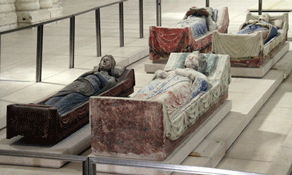 |
 |
 |
|
Far left: Hand coloured etching by
Charles Stothard of the effigy of Henry II before its restoration. Left: Similar of Eleanor of Aquitaine Right: Similar of Richard the Lion Heart Far Right: Similar of Isabelle of Angoulême Above: The effigies as they are arranged today. |
 |
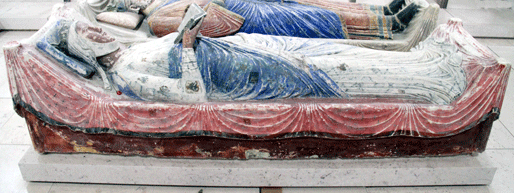 |
| Henry II 1189 | Eleanor of Aquitaine 1204 |
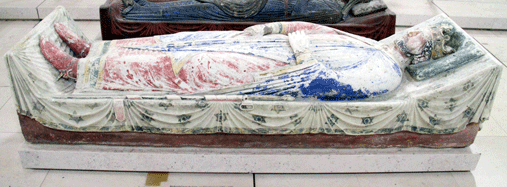 |
 |
| Richard the Lion Heart 1199 | Isabelle of Angoulême 1246 |
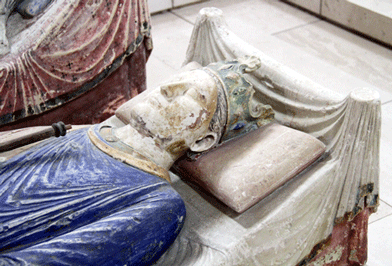 |
 |
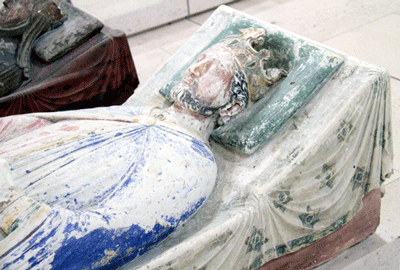 |
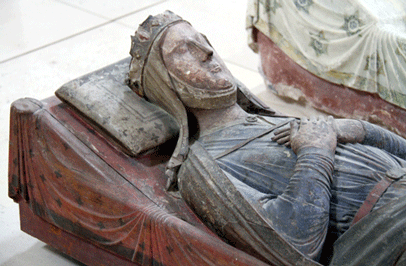 |
| Early Drawings of the Effigies from the Gaignières Collection (c.1700) | ||
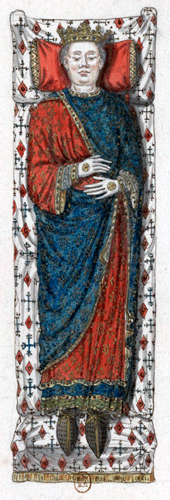 |
 |
  |
| This pre-revolutionary
collection of drawings of the Fontevraud effigies, executed
before 1700 - and about 100 years before the Stothard etchings -
shows them in a relatively undamaged stage; particularly showing
that Eleanor
is still holding her book which had broken away with most of
both her hands by the time Stothard visited Fontevraud. In neither of these collections is Henry or Richard shown holding a scepter. If you visit the monuments today you will find that Henry is doing just that while Richard is not. It is quite possible that Henry did hold a scepter from the position of his hands and the fact that royal effigies usually did so. Richard does not hold a scepter today although one was added for a while and can be seen in early photographs of his effigy. The position of his hands makes it unlikely that he is holding a scepter in the manner of his father. The royal effigies in Saint-Denis are represented as holding a scepter with one hand only - as is Richard's effigy at Rouen - and often resting it on the shoulder with the other hand holding a garment; perhaps this was the case here. |
||
| Some Notes on the Monuments |
|
Because the effigies of Henry and Richard are of similar appearance - note the relatively low relief and the folds of the garments - it is thought that they were both constructed around same time, probably on the orders of Eleanor; this would date them to the first years of the 13th century. That of Eleanor was constructed later - note the higher relief and the more realistic carving of the drapery folds - most likely later in the same century. That of Isabelle presents a problem: it is smaller and made of wallnut. Isabelle died at Fontevraud in 1246 and was originally buried in the nuns' cemetery. Her son King Henry III visited Fontevraud (Gascony was still in English hands) and ordered that his mother's remains be transferred to the church and a monument made. Perhaps the wooden effigy was carved at this time so that Henry III could see it, there being no stone carver nor sufficiently large stone block on site at that time. Perhaps this was a prototype and it was intended that a tuffeau effigy would be constructed later. This, however, is speculation as I have found no relevant references. It is generally agreed that the tuffeau female effigy is that of Eleanor and the the two male effigies are those of Henry and Richard. But which is Henry and which is Richard? They are traditionally ascribed as above but foremost Plantagenet expert Professor John Gillingham expresses uncertainty. The authorities at the Abbey tell me that they have evidence for the identification but they have never presented it to me. The late art historian Professor George Zarnecki stated that the wooden effigy cannot be that of Isabelle as she died more than forty years after the others and that the effigy was constructed at the same time as that of Eleanor. I believe that he bases the latter assertion on the fact that the design is similar to that of Eleanor's and that an effigy of a different style would have been constructed forty years later. This seems to me to be unsound reasoning as there is nothing to stop a later effigy being constructed in an earlier style, which is only forty years earlier anyway. Furthermore he does not indicate whom the effigy might possibly represent. The fact that the effigy is made of wood also contradicts his statement, which I think can be totally rejected. A little more about Isabelle may be found here. This is taken from a Monument of the Month article in the Church Monuments Society website, which I wrote some years ago. |
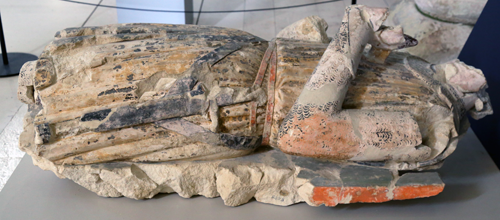 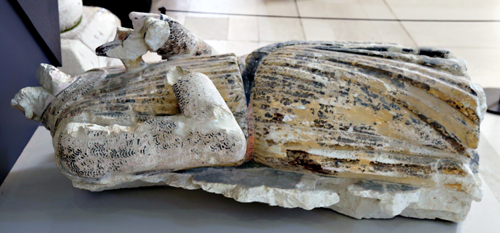 |
Other Monuments |
-029.png) |
 Above: Pierre de Poitiers, Bishop of Poitiers. Destroyed Gaignières Collection |
| Above far left and far right:
Effigy of Raymond VII, Count of Toulouse. He
was the son of Raymond VI and Joanne, the daughter of Henry and
Eleanor. The wall painting has been on diplay from when it was
first oncovered. The effigy was discovered during the excavation
of the abbey church floor in the 1980's and has been kept
out of public view in the stone store. It appeared in the church
during a Plantagenet exhibition in autumn 2021; I hope he
remains there! The tuffeau effigy is in a damaged condition but much of the polychrome remains. Raymond VII and his father Raymond VI were victims of the wicked Albigensian Crusade which overran the County of Toulouse destroying property and killing a large number both combatants and non combatats, many of whom were burned alive. This was certainly a great disgrace on the name of medieval Christianity. |
 |
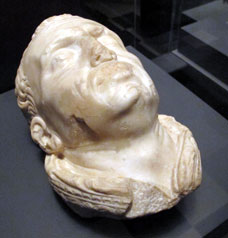 |
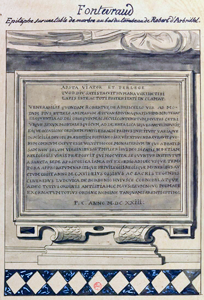 |
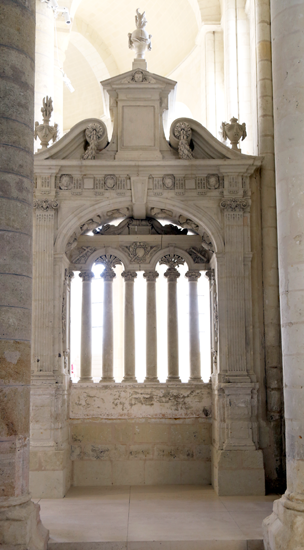 |
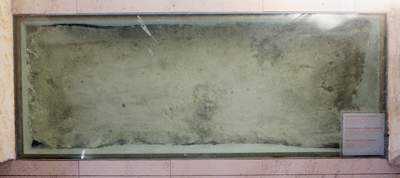 |
|||
| Above left: Early 17th century monument to Robert d'Arbrissel (c 1117) Probably drawn later that century. (Gaignières Collection) Centre Top Left: Head from the destroyed effigy, the only fragment remaining of the effigy; now on display in the 'treasury' - the original warming room, which leads from the east aspect of the main cloister. Centre Top Right: Epitaph from the tomb chest. Center Bottom: His coffin is shown just below the floor of the abbey church between two pillars on thesouth aspect of the choir. Right: The superstructure of the monument today. The tomb chest and the torso of the effigy are lost. This monument was commissioned by Abbess Louise de Bourbon Langdon and carved by Gervais De La Barre in the 17th century; she also commissioned the effigy, mostly lost. | |||
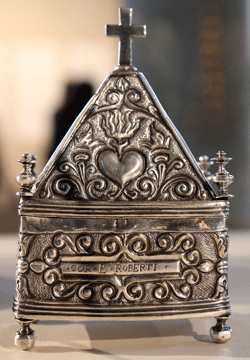 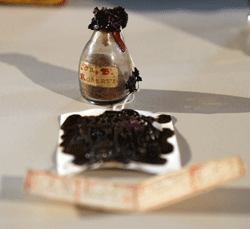 |
Robert d'Arbrissel Exhibition at
Fontevraud 12th and 13th November 2016 |
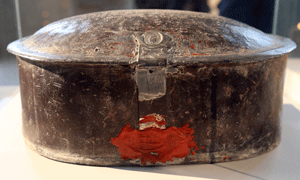 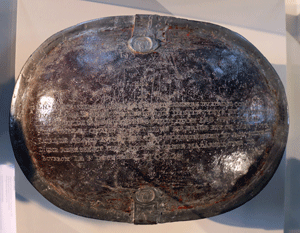 |
|
Robert d'Arbrissle did not die at
Fontevraud but at another of his foundations, the Priory of
Our Lady of Orsan at Maisonnais, Berry in 1116. The nuns and
monks of Fontevraud who has arrived at Orsan a few days
before Robert's death, carried his body back to their
abbey and deposited them in the cloister for safe keeping.
However a deputation arrived from Berry and carried the body
by force back to Orsan and ordered a sarcophagus, totally
ignoring Robert's last wishes to be buried in the mud of Fontevraud.
The Abbess of Fontevraud, Petronille de Chamillé, resisted,
calling on the Pope, God and threatening a hunger strike of
the community. Finally, after many negotiations, it was decided that his heart was to
remain at Orsan while his unembalmed body was to be returned to
Fontevraud. Abbess Petronille de Chemillé, following the founder's wishes, did not particularly favour the veneration of Robert and by burying him in the choir of the abbey church, it was not possible for the public to visit his tomb. (see above) She did, however, submit papers to the then pope, Calixtus II, during his visit to Fontevraud in the summer of 1119, in an attempt to effect his canonization although this was in vain. In 1621 Abbess Louise de Bourbon, one of the few abbesses who wished to maintain the cult of Robert, organized the construction of a memorial to his memory (see above). This necessitated opening of the original tomb and the bones found therein were enclosed in a lead casket and placed in the new tomb to which the public still did not have access. (right) She also submitted papers to the then pope, Clement IX, in a further attempt at Robert's canonization but this came to nothing following the death of both the Pope and the Abbess shortly afterwards. |
| A further attempt at canonization
occurred in 1853, the Fontevraud sisters submitting a
petition to the Holy See. This again failed because of
Robert's alleged vices. Nevertheless the title 'Blessed' is
granted to him in the calendar of the church of Poitier. In contrast the Prioress of Orsan encouraged public veneration of Robert, his heart being enclosed in a 'stone pyramid'. At some point the heart was transferred to a silver reliquary. (Left top) which now contains a small bottle holding the remains of the heart. (Left bottom). The last of the nuns left Fontevraud in 1792 but the observance of the Order of Fontevraud persisted in the daughter houses of Chemillé, Brioude and Boulaur. In the early part of the 19th century excavations at Fontevraud led to the discovery of the lead casket referred to above, and this, presumably with the silver reliquary, were entrusted to the nuns of Chemillé in 1847. In 1956 the Order of Fontevraud was attached to the Benedictine Order and in 1961 the Chemillé nuns joined the Benedictine Priory of Barre, in Martigné-Briand, Maine-et-Loire, taking the relics with them. These box and reliquary were brought temporarily at Fontevraud for the above exhibition The inscription on the lid of the lead box (above bottom right) are in French which may be translated thus: 'In this coffer are the bones and ashes of the worthy body of the venerable Father Robert d'Arbrissel, a teacher and founder of the Order of Fontevrault, which were found in his tomb when it was raised and erected in this place beside the great altar by command and care of the worthy Abbess and Head of the said Order Lady Loyse de Bourbon on 5th October 1622.' Note that Robert d'Arbristle is referred to as 'Father'. Although there were attempts to canonize him this failed and he had never received the title of Saint or Blessed at that time. Note also the older or alternate spelling of Fontevraud. |
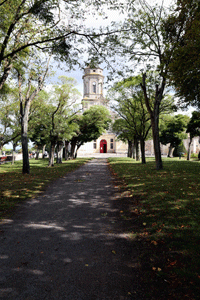 |
Saint-Florent-le-Vielle Abbaye de Saint-Florent |
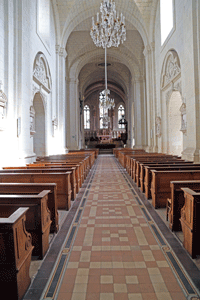 |
| Enter the village and then head for 'Maire Abbaye' listed on the brown sign posts. Park in free car park nearby. Church is open, entry is free and there is no restriction on photography. |
 |
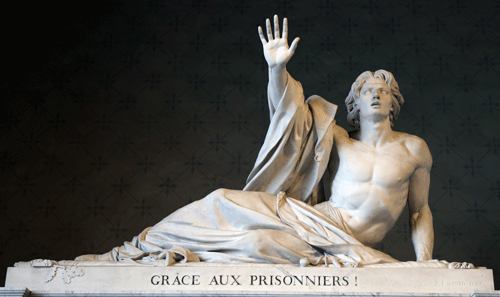 |
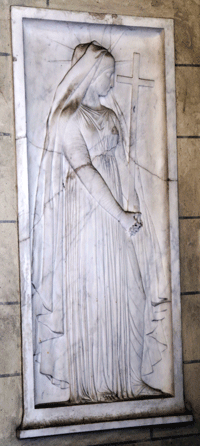 |
|
Charles-Melchior Argus, Marquis of Bonchamps
d.o.w. following Battle of Cholet
(1792) By
David of Angers (Pierre-Jean David)
(1825) His last act was to pardon 5,000 republican
prisoners whom his troops had vowed to kill in revenge
for his death; the sculptors father was one of them.
Bonchamps was admired by royalists and republicans
alike.
|
||
.
Missire Françoic-Henry
de Menon (16 - -) and Dame
Madeleine de la Tour (1627) |
|
